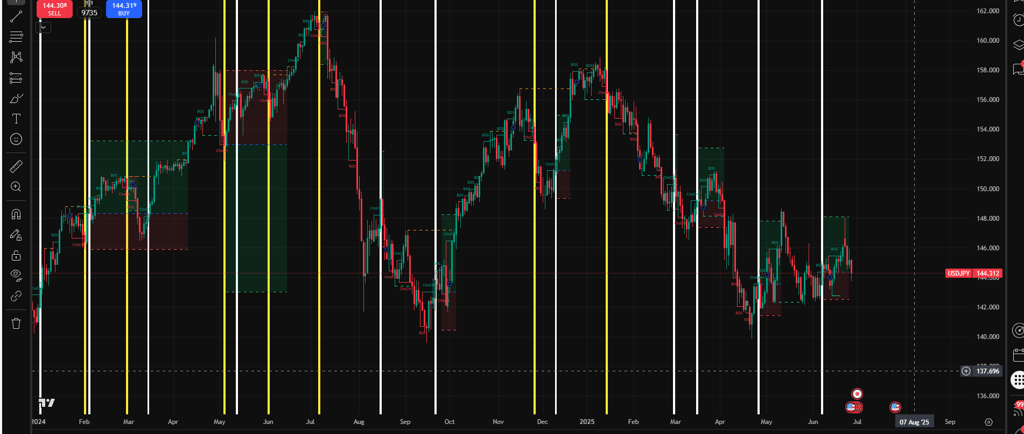Liquidity Algo Performance on USDJPY
6/26/20253 min read


Exploring a Data-Driven Approach to the USDJPY Market
The USDJPY currency pair, representing the exchange rate between the US Dollar and Japanese Yen, is one of the most actively traded pairs in the forex market. Its popularity stems from the economic weight of the two nations it represents and the pair's historical volatility. However, trading USDJPY requires a deep understanding of market dynamics, given its sensitivity to macroeconomic changes and geopolitical events.
In this context, algorithmic trading tools have become indispensable for navigating the complexities of the forex market. One such tool is an innovative algorithm designed by Sachin Babu Antony ((https://www.linkedin.com/in/sachin-babu-antony-9877171ba/)), a data scientist specializing in financial technologies, to analyze USDJPY trends and provide actionable insights to traders.
Understanding the USDJPY Algorithm
At its core, the algorithm leverages historical price data, technical indicators, and real-time market analysis to identify patterns and trends. It is designed to assist traders in making informed decisions by pinpointing key levels, entry and exit points, and potential reversals in the USDJPY market.
The algorithm is structured to adapt to changing market conditions, ensuring its predictions remain relevant in both stable and volatile scenarios. This adaptability is particularly crucial for USDJPY, as the pair often responds to sudden shifts in global economic policies, interest rate changes, and investor sentiment.
Key Features of the Algorithm
1. Pattern Detection: The algorithm identifies recurring patterns in the USDJPY chart, including candlestick formations, breakout zones, and support/resistance levels. These patterns provide traders with a clear visual representation of potential market movements.
2. Trend Analysis: By analyzing key technical indicators such as moving averages, RSI (Relative Strength Index), and Bollinger Bands, the algorithm detects bullish and bearish trends. This helps traders align their strategies with prevailing market conditions.
3. Risk Management: A crucial aspect of the algorithm is its focus on risk management. It calculates potential drawdowns and suggests stop-loss levels, enabling traders to minimize losses during unfavorable market conditions.
4. Market Sentiment Integration: Beyond technical analysis, the algorithm incorporates sentiment analysis by evaluating news reports, economic data releases, and social media trends. This provides a comprehensive view of market dynamics.
5. Customizable Timeframes: The algorithm allows traders to customize its analysis based on their preferred timeframes, whether they are day traders, swing traders, or long-term investors.
The Algorithm in Action
The accompanying USDJPY chart demonstrates the algorithm’s application, with vertical lines marking significant market events or insights generated by the tool. These include potential reversal points, breakout signals, and areas of consolidation. By visualizing these moments, traders can better understand the logic behind the algorithm's recommendations.
For instance, in periods of heightened volatility, the algorithm effectively identifies breakout zones where the market is likely to move decisively. Similarly, during consolidations, it highlights key support and resistance levels, allowing traders to plan their trades accordingly.
Why Algorithms Matter in Modern Trading
The forex market operates 24/7, with price movements influenced by a multitude of factors, including economic policies, geopolitical tensions, and global trade dynamics. For human traders, keeping track of these variables in real-time can be overwhelming. Algorithms bridge this gap by processing vast amounts of data quickly and accurately, providing traders with a clear edge.
Specifically for USDJPY, where market movements are often driven by unexpected events like central bank announcements or economic data releases, having an algorithm that can adapt to real-time changes is invaluable. It not only saves time but also reduces the emotional bias that often clouds trading decisions.
Benefits of Using the Algorithm for USDJPY
- Efficiency: The algorithm streamlines the analysis process, allowing traders to focus on execution rather than spending hours analyzing charts.
- Consistency: By removing emotional decision-making, the algorithm ensures a consistent approach to trading.
- Scalability: Whether you’re trading small or large volumes, the algorithm can be tailored to suit your trading style and risk appetite.
The Role of Sachin Babu Antony in Algorithm Development
Sachin Babu Antony brings extensive expertise in data science and financial markets to the development of this algorithm. His ability to integrate technical analysis with machine learning principles has resulted in a tool that is both accurate and intuitive. By addressing the unique challenges of USDJPY trading, Sachin has created an algorithm that empowers traders to make better decisions in real-time.
The Role of Technology in Forex Trading
The integration of machine learning and data science into forex trading represents a paradigm shift in how traders approach the market. Algorithms like this one are not just tools—they are strategic partners that empower traders to make better decisions. As the forex market continues to evolve, the role of such technologies will only grow.
Conclusion
The USDJPY algorithm exemplifies the power of data-driven trading strategies. By combining technical analysis, sentiment evaluation, and risk management, it provides a comprehensive solution for navigating the complexities of the forex market. Whether you’re a seasoned trader or just starting, tools like this can help you stay ahead in an increasingly competitive landscape.
For those interested in exploring algorithmic trading further, liquidity algo serves as a great example of how data science can transform traditional trading practices. As we move toward a future where technology plays an even greater role in financial markets, adopting such algorithms isn’t just an advantage—it’s a necessity. For anyone trading USDJPY, leveraging a well-designed algorithm can make all the difference between success and missed opportunities.
